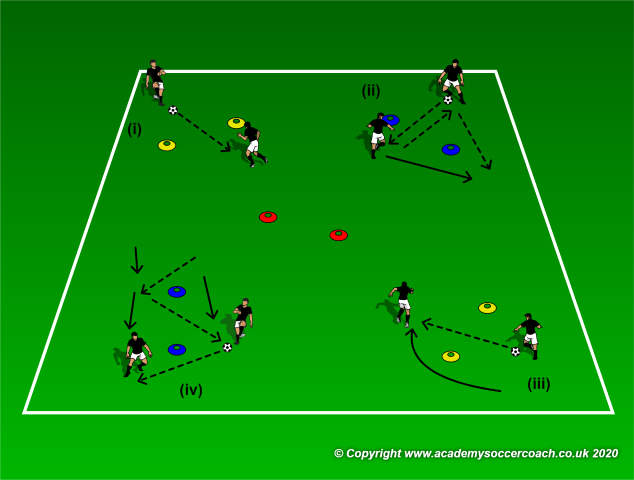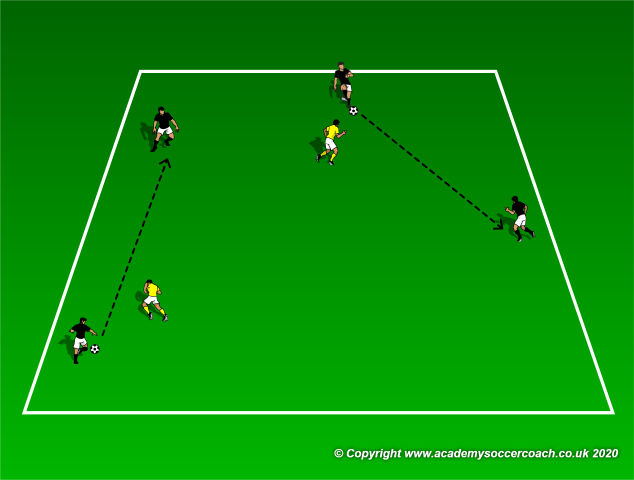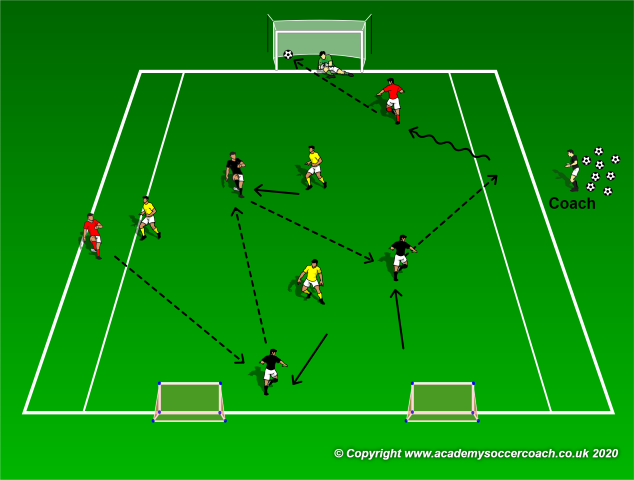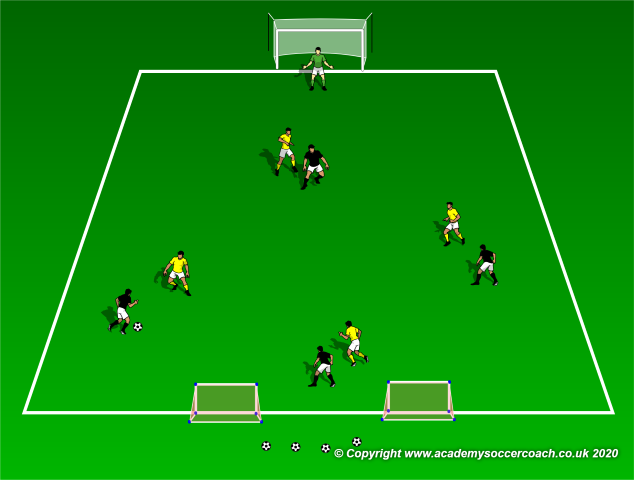By Philip Cauchi
Introduction: In this session we will work using the structured method of FC Barcelona’s Francisco ‘Paco’ Seirul-lo. FC Barcelona view the player as an individual composed of eight structures which are interrelated and affect each other. Through optimised planning of our training sessions, we can develop these structures within a specific stage space of the game. These stage spaces are ‘ball possession’ and ‘ball recovery’. The training session is divided into three stages which builds on the structures that we want to develop in our players. The physical, technical, tactical and mental domains should always be present in our training sessions.
The eight structures that form the player.
N.B. The training situations are purposely selected to develop specific structures. In each training situation in this session we concentrate on a maximum of three structures.
Bio-energetic: This is the energy that the player as a human needs in order to survive. It is the foundation which helps the player to excel in the other structures and be focused and concentrated throughout a match or training.
Conditioning: These are the elements of strength, speed, endurance that enables the players to carry out the required football actions at a high quality and for the duration of the match.
Coordination: These are the quality of the motor movements that the players need to make both with and without the ball and which satisfy the requirements of the context they are in. The higher the quality the quality of the movements the higher the chance of a successful outcome.
Cognitive: The best players are those who can extract information from the environment through their stimuli, perceive the correct situation, choose the best option from a number of alternatives, and execute the decision through a technique.
Socio-effective: The players need to work well together as a group in order to function both effectively and efficiently as a system. Communication between the players is of paramount importance.
Emotional-volitional: Without motivation and internal drive to succeed we will not get anywhere. Are our players motivated to practice or compete?
Creative expressive: Creative players are the ones who make the difference. How creative are our players? Are they proactive or do they depend on our instructions all the time? Do the players recognise spaces which they can exploit? Can they create scoring changes through their own movement?
Mental: Are the players able to bounce back immediately when something goes wrong? Do they keep their focus on the game or do they lose their cool?
The training session:
Aim: To create and convert goal-scoring opportunities.
Level: Under 10 to under 12 (medium to high ability).
Duration: 75 minutes.
Stage 1: Coordination and cognitive tasks with the ball.
We introduce the players to work in rhythm with each other while performing different type of motor movements.
Training situation 1: Passing through the gates.

Organization: Area measures 25 yards by 12 yards. Players are paired and each pair has a ball. A number of gates are scattered inside the marked area as shown in the below diagram.
Duration: 10 minutes
Description: Pairs dribble and pass the ball through the gates. After passing the ball through a gate, they have to move by dribbling the ball to another gate and repeat.
Progressions:
1. Receiving player passes back to the passer to receive the ball at an angle outside the gate (marked as ii in the above diagram).
2. Play a through pass through the gate (marked as iii in the above diagram).
3. Zig-zag passing (marked as iv in the above diagram).
Targeted structures:
Coordination: Timing of and quality of passes within space.
Socio-affective: Communicating both verbally and non-verbally. The ball is the means of communication between the two players.
Training situation 2: Protect the ball!

Organization: Area measures 15 yards by 12 yards. We have four attackers, two defenders and two balls.
Duration: 10 minutes (in series of 2 minutes each interspersed with 1 minute of dynamic flexibility)
Description: The defenders aim to get possession of one of the two balls and dribble it outside the area. They change places with the attacker responsible for the loss of the ball.
Progression: Reduce the area to 12 yards by 10 yards.
Targeted structures:
Coordination: Awareness of space, timing and quality of passes and quality of first touch.
Socio-affective: Distances and angles of support between the players, verbal and visual communication between the players.
Cognitive: The players move to the correct position to support the player with the ball.
Stage 2: Optimization sub-dynamic.
We connect the training situations in this stage to the bigger picture, which means the realism of the global game. This are smaller chunks of the whole puzzle but with an intended direction (aim of the session) in mind.
Training situation 3: 4v2 to score with 2v4 counter.

Organization: The area of practice should measure 20 yards by 12 yards within a bigger area measuring 36 yards by 28 yards. Two mini goals are positioned at one end line inside the smaller area. Both teams have two players inside the smaller area. The black players have another two perimeter players positioned at the high and low ends of the area, while the yellows have a player positioned at each lateral side of the area.
Duration: 15 minutes.
Description: Play always starts by the attacking team from their end line (between the two mini goals). When the attacking team have the ball they aim to score in the regular goal with the help of the perimeter players. When the ball is played outside the small area, the situation becomes a 1v0 with the attacker against the goalkeeper. If the defenders win possession they aim to score in any of the two mini goals. The four yellow players play against two black defenders as the perimeter players of the latter team do not participate in the defending part.
Variation: The attacker with the ball may dribble out of the small area to attack the goal.
Progressions:
1. A defender is allowed to follow the attacker.
2. Two defenders and another attacker follow the play thus making the situation a 2v2.
3. Two defenders follow the play thus putting the attacker at a 1v2 disadvantage.
Targeted structures:
Coordination: Timing of and quality of passes to space or feet. Timing of forward runs to meet the through pass.
Cognitive: Scan the area, get to know the options before receiving the ball, select the best option (pass, protect the ball, dribble or shoot) to execute the decision taken.
Socio-affective: Communicating both verbally and non-verbally. Distances and angles between the players.
Stage 3: Finalization sub-dynamic.
We aim to finalise the session by working on the main aspects of the session to refine and consolidate them within the game. In these two games we focus on improving the players’ performance in the game in the possession stage but especially when creating and converting scoring opportunities. For the players to mentally assimilate this game with the regular game the scoring opportunities and problem solving in this sector must be constantly repeated.
Training situation 4: 3v3+2 neutral wing players on a regular goal and two small goals.

Organization: The area of practice should measure 36 yards in length by 28 yards in width. A two yard channel should be marked at both flanks. In this channel the neutral players acting as wingers are to be positioned. A regular goal is positioned at one end while another two mini goals are to be positioned at the opposite end. Two teams of three players. One of the two teams has a goalkeeper who defends the regular goal.
Duration: 15 minutes (4 series x 3 minutes with 1 minute of rest in between).
Description: No corner kicks or throw-ins are allowed. The coach puts a ball into play every time the ball goes out of playing bounds. When a goal is scored, the team suffering the goal must restart play from close to their goal immediately. The three black players attack the goal protected by the yellow team and the goalkeeper. The yellow aim to recover the ball and score in any of the two mini goals. The neutral players may cut inside both with and without the ball in order to attack the goal. After two series the teams change goals while the goalkeeper remains defending the regular goal.
Targeted structures:
Coordination: Timing of and quality of passes to space or feet. Body stance to receive the ball. Timing and quality of runs. Applying the technique correctly even when under opposition pressure.
Cognitive: When in possession the players should scan the area well, be in the right position, with the appropriate body stance, and know how, where and the direction to move to create space.
Socio-affective: Communicating both verbally and non-verbally. Distances and angles between the players. Movement off-the-ball to open space.
Training situation 5: 4v4+GK – Big goal and two mini goals.

Organization: The area of practice remains 36 yards in length by 28 yards in width. A regular goal is positioned at one end while another two mini goals are to be positioned at the opposite end. Two teams of four players. The team who is defending the regular goal has a goalkeeper.
Duration: 15 minutes.
Description: One team (in the diagram above are the blacks) attack the regular goal while the yellows attack the opposite two mini goals. No corner kicks or throw-ins take place. Play always starts from the end line of the team in possession.
Targeted structures:
Coordination: Timing of and quality of passes to space or feet. Body stance to receive the ball. Timing and quality of runs. Applying the technique correctly even when under opposition pressure.
Cognitive: When in possession the players should scan the area well, be in the right position, with the appropriate body stance, and know how, where and the direction to move to create space.
Socio-affective: Communicating both verbally and non-verbally. Distances and angles between the players. Movement off-the-ball to open space. Applying pressing actions together as a group to recover the ball.
Emotional-volitional: A positive attitude to win. Attitude to recover the ball immediately after it is lost.
Mental: Can the players keep focused even if the opponents are winning or after making a mistake?
Cool down:
Duration: 10 minutes.
Passing the ball in twos followed by static stretching exercises and a quick Q and A with the players to recapitulate the key points of the training session.
By Philip Cauchi


